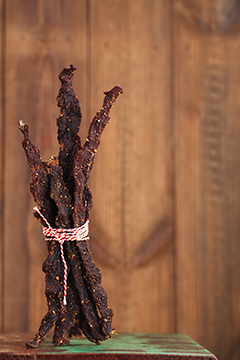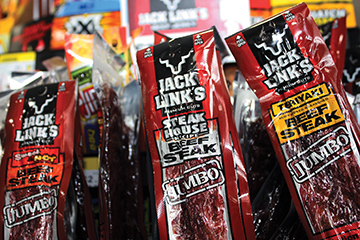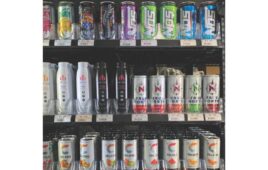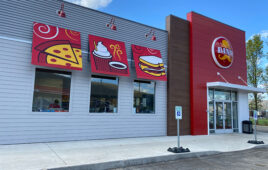 Meat bars forge a unique position in the meat snacks category.
Meat bars forge a unique position in the meat snacks category.
By Anne Baye Ericksen, Contributing Editor
Every once in a while, a new type of product enters the marketplace that doesn’t neatly fit into an existing category. Meat bars is one of the latest examples of this phenomenon. Although they contain many of the same ingredients as jerky, their consistency is softer and easier to chew.
High in protein, meat bars are much different than other products marketed as protein bars that feature nuts, dried fruit and also happen to be high in sugar. Also, do people buy meat bars as an impulsive snack-on-the-go item that competes with single-serving meat sticks? Or are they more of a purposeful purchase, one that customers are intent on buying when they enter a convenience store?
When a product exhibits multiple personality traits, it can pose a challenge in terms of strategizing in-store displays and promotions. Where do you position a product that technically falls within the definition of meat snacks, but also appeals to customers looking for better-for-you (BFY) snacking options?
These are the types of questions facing convenience store managers and operators as meat bars continue to gain popularity among consumers and as the market grows with new brand introductions.
MEAT OF THE MATTER
Over the past couple of years, marketers have touted the influence Millennials exert in the retail space, and one of the more persuasive trends this group has initiated is the desire for BFY snacks.  Because 18- to 34-year-olds are less likely to sit down to full meals and more likely to snack throughout the day, they’re looking for food choices that will satiate them for extended periods.
Because 18- to 34-year-olds are less likely to sit down to full meals and more likely to snack throughout the day, they’re looking for food choices that will satiate them for extended periods.
The Mintel Group reported that nearly three-fourths of consumers express a desire for healthier salty snack options, and that 79% want to be able to recognize a snack’s ingredient list. Also, IRI research stated that 44% of consumers look for snacks that are natural or organic. Another 60% of those polled prefer snacks that will provide an energy boost.
Meat snacks satisfy many of these requirements, and have been cashing in on the trend. According to CarbonView Research, meat snacks are one of the top four food items Millennials purchase in c-stores.
“Meat snacks has been a star performer in savory snacks, with a minimally processed image and high-protein content that serves as an appetite suppressant and energy booster,” said Jared Koerten, lead analyst for Euromonitor International.
“We are seeing a lift in all-natural brands, no preservative (no MSG) brands like Lorissa’s Kitchen. Many of these all-natural brands have a softer product, so I think this softer chew makes it really inviting for females and it opens up the category to a lot of consumers that don’t like traditional meat jerkies,” observed Charlotte Havely, director of marketing for Weigel’s. The convenience store chain, headquartered in Powell, Tenn., operates more than 60 sites throughout the Volunteer State.
“Meat snacks are definitely continuing to trend as consumers are looking for high-quality protein in today’s healthier lifestyle. It’s a nice healthy alternative to the traditional salty snack, like potato chips,” she added.
According to Nielsen Research, meats snacks on a whole tallied up approximately $1.4 billion in sales. What’s more, category sales rose more than 55% between 2010 and 2015.
“Products that can offer high-protein content, for instance, have grown in popularity as consumers look for satiety for meal replacement,” said Koerten. “This has helped drive growth in nuts, seeds and trail mixes and other savory snacks (primarily meat snacks), which both grew current value sales by 3% in 2016.”
Analysts also anticipate further growth, partially bolstered by new product offerings released over the past few years.
“As jerky expands beyond its core audience of younger male consumers, brands like Krave have found success with gourmet offerings and artisanal flavors,” said Koerten.
Krave, purchased by Hershey last year, is an example of a specialty jerky gaining widespread acceptance. In September, it revealed the Krave Bar at the Natural Products Expo East show. Competition is increasing as other major food manufacturers acquire smaller artisan brands. Earlier this year, cereal giant General Mills purchased Epic Provisions, the producers of Epic bars.
Independent producers also are attracting investors to finance brand development and broaden distribution beyond specialty shops and online sales, and into more mainstream retail outlets such as convenience stores. Wilde Brands LLC—which makes meat bars in chili lime, peach barbecue, strawberry black pepper and maple bacon blueberry—secured more than $1.5 million in funding in 2015.
The marketplace also has attracted startup brands. Recent additions to hit store shelves include meat bars by Kratos Foods, Omnibar and Caveman Foods.
While sales of traditional meat snacks, such as jerky and sticks, also show healthy growth and provide c-stores fairly high profit margins, market researchers pin more value on the fact that meat bars project an updated image for the category. Not only do meat bars qualify as BFY and high-protein snacks, they’re also seen as gourmet and artisanal.
Featuring poultry and game as well as beef, more bars come in a full menu of flavor pairings not typically offered by other meat snacks. Epic Bars, for example, sells combinations such as bison bacon cranberry, beef habanero cherry and lamb currant. Mintel reported 38% of consumers say their snacks purchases are influenced by new flavor releases.
CREATING A PRESENCE
By all accounts, demand for meat snacks is on a steady incline, whether it’s driven by traditional cravings or a wish for BFY options. That’s the good news. The bad news, though, is that market research indicates retailers are missing out on maximizing the profit potential. Nielsen Research stated that meat snacks are under-placed by at least 13%, and that could climb to 23% in less than five years.
A common planogram for meat snacks is to have bags of jerky, nuggets and meat sticks bunched together in high-traffic locations, such as near fountain drink stations. Additionally, single-serving packages are placed near registers to capture last-second impulse purchases. And it’s a strategy that has been effective for most businesses.
“We continue to see positive trends in big value bags,” said Havely. “I think this is due to all the price increases/bag-size shrinkage in the category. So that person, who’s coming in to buy the big bag, definitely sees the economic value of the big bag.”




